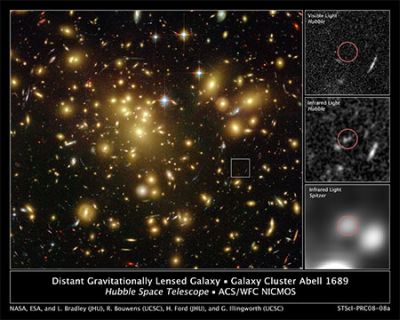13 March 2008

NASA’s Hubble and Spitzer space observatories have joined forces to discover one of the youngest known galaxies in the early Universe. Interestingly, the powerful telescopes were aided by a natural "zoom lens," an effect known as gravitational lensing, which magnified and intensified the image of the distant galaxy.
The galaxy, known as A1689-zD1, is believed to have formed only 700 million years after the Big Bang, in the middle of the Universe’s “dark ages”, one of the earliest eras of the cosmic evolution. (The Universe is estimated to be 13-14 billion years old.) The light from A1689-zD1 took nearly 13 billion years to reach Earth!
The high resolution images from the Hubble Space Telescope (HST) reveal the infant galaxy, which undergoes an energetic process of star formation. Infrared images from the Spitzer Space Telescope (SST) confirmed the startling discovery.
"We certainly were surprised to find such a bright young galaxy 12.8 billion years in the past," said astronomer Garth Illingworth (University of California), a member of the team of researchers. "This is the most detailed look to date at an object so far back in time."
"The Hubble images yield insight into the galaxy's structure that we cannot get with any other telescope," explained astronomer Rychard Bouwens, a co-discoverer. The new images should provide valuable insights into the earliest stages of the formation and evolution of galaxies. The distant galaxy is regarded as a prime target for Hubble's successor, the James Webb Space Telescope, scheduled for launch in 2013.
During its mission, HST has peered ever further into the early Universe, revealing galaxies at successively younger ages. These pictures have enabled astronomers to document galaxies from infancy to maturity. The new Hubble and Spitzer images of A1689-zD1 unravel an era when galaxies were in their infancy.
It is believed that the dark ages began about 400,000 years after the Big Bang, as matter in the expanding infant Universe cooled and formed clouds of cold hydrogen. These cold clouds pervaded the Universe like a thick fog. The first stars and galaxies began to form at some point during this era. Their radiation reheated the foggy, cold hydrogen, bringing the dark ages to an end, about a billion years after the Big Bang.
"This galaxy presumably is one of the many galaxies that helped end the dark ages," said astronomer Larry Bradley of Johns Hopkins University, and lead author of the study. "Astronomers are fairly certain that high-energy objects such as quasars did not provide enough energy to end the dark ages of the Universe. But many young star-forming galaxies may have produced enough energy to end it."
The galaxy is so remote that it evaded detection in visual light images taken with Hubble's Advanced Camera for Surveys (ACS), because its light is stretched to invisible infrared wavelengths, due to the expansion of the Universe.
Interestingly, the galaxy’s image was magnified and brightened by a magnificent natural telescope, a phenomenon known as a gravitational lens.
A gravitational lens is observed when light rays from a very distant cosmic object (such as a galaxy) are deflected around a nearer massive object (such as a cluster of galaxies), situated between the distant object and Earth. The effect was predicted by Albert Einstein's theory of General Relativity.
A relatively nearby massive cluster of galaxies, roughly 2.2 billion light-years away, magnifies and intensifies the light from the much more distant A1689-zD1, which lies near the cluster’s direction in space. The sophisticated infrared detectors of Hubble and Spitzer allowed the galaxy’s infrared light to be recorded.
Further Reading
Astronomers Eye Ultra-Young, Bright Galaxy in Early Universe
http://www.spitzer.caltech.edu/Media/releases/ssc2008-04/release.shtml
Aymen Mohamed Ibrahem
Senior Astronomy Specialist